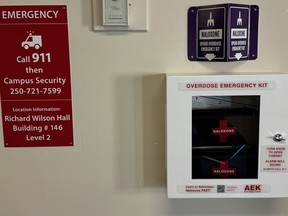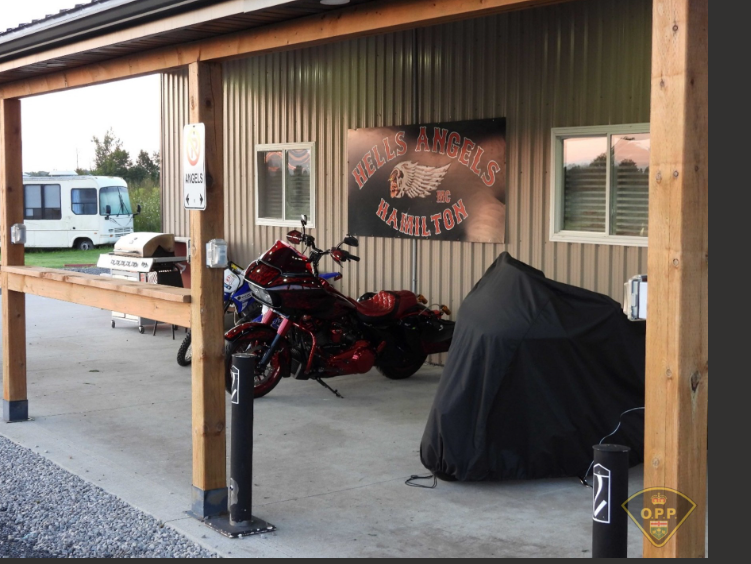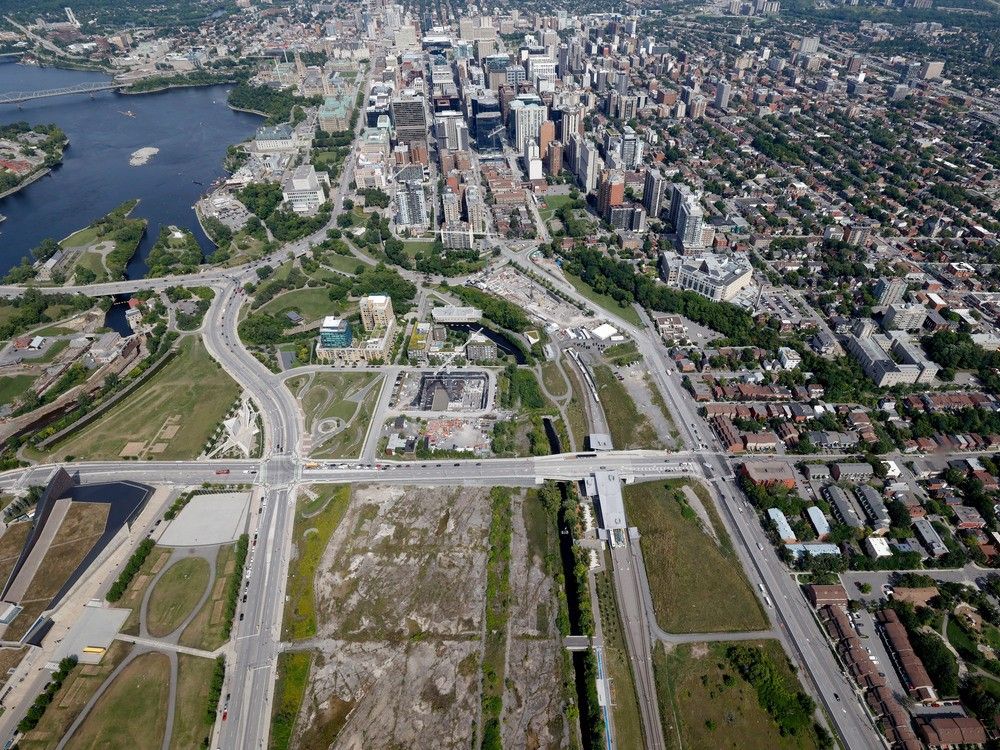Naloxone kits are now available in student buildings on university and college campuses, following the preventable death of a UVic student
Published Sep 04, 2024 • Last updated 0 minutes ago • 4 minute read

Many of the 300,000 students flocking to B.C.’s 25 university and college campuses this week will encounter something they haven’t seen before: 1,600 new nasal naloxone kits, many hung on walls in dorms, bars and other high-traffic buildings.
The easy-to-use, overdose-reversing drug will now be more readily available on campuses, and first-year students are to be told during their orientation where to find the kits.
Advertisement 2
THIS CONTENT IS RESERVED FOR SUBSCRIBERS ONLY
Subscribe now to read the latest news in your city and across Canada.
- Unlimited online access to articles from across Canada with one account.
- Get exclusive access to the Vancouver Sun ePaper, an electronic replica of the print edition that you can share, download and comment on.
- Enjoy insights and behind-the-scenes analysis from our award-winning journalists.
- Support local journalists and the next generation of journalists.
- Daily puzzles including the New York Times Crossword.
SUBSCRIBE TO UNLOCK MORE ARTICLES
Subscribe now to read the latest news in your city and across Canada.
- Unlimited online access to articles from across Canada with one account.
- Get exclusive access to the Vancouver Sun ePaper, an electronic replica of the print edition that you can share, download and comment on.
- Enjoy insights and behind-the-scenes analysis from our award-winning journalists.
- Support local journalists and the next generation of journalists.
- Daily puzzles including the New York Times Crossword.
REGISTER / SIGN IN TO UNLOCK MORE ARTICLES
Create an account or sign in to continue with your reading experience.
- Access articles from across Canada with one account.
- Share your thoughts and join the conversation in the comments.
- Enjoy additional articles per month.
- Get email updates from your favourite authors.
Sign In or Create an Account
or
Article content
This is one of several overdose-prevention changes happening on B.C. campuses in response to the preventable death in January of a University of Victoria student, Sidney McIntyre-Starko. She collapsed from drug poisoning in a residence, but students didn’t have immediate access to naloxone, campus security officers waited too long to administer it, and the 911 operator wasted precious time trying to determine the location of the building.
The promised changes are to take place at all B.C. universities and colleges — both large and small, urban and rural, and with or without student housing.
“Every single institution has put nasal naloxone publicly available across campuses. The public awareness campaign is provincewide. All 25 institutions are working with us and are on board,” Post-Secondary Minister Lisa Beare said.
After Postmedia and Sidney’s parents documented the deadly delays in the emergency response provided to the 18-year-old student, the province announced a coroner’s inquest into the case and struck an overdose prevention steering committee that included health, academic, and Indigenous experts.
By signing up you consent to receive the above newsletter from Postmedia Network Inc.
Article content
Advertisement 3
Article content
Among the committee’s directives for post-secondary institutions:
• Naloxone kits, which contain two doses, should be available in each student housing or floor, at school events including those where alcohol is served, in first-aid kits on campus and taken on field trips.
• Orientation packages should contain information on how to recognize an overdose and the location of naloxone kits, and instructions to phone 911 first in an emergency.
• All students should be informed of the toxic drug supply and told about resources to reduce or stop drug use, as well as respond to an overdose.
• Disciplinary policies should be revised so that students do not hesitate to report an overdose because they fear they will be suspended for drug use.
• Campus security officers should receive training for how to recognize an overdose and how to use naloxone.
Guidelines for how to train security officers and other campus staff, such as residence supervisors, should be formalized over “the coming months,” Beare said.
Another policy still being finalized is how schools should notify relatives when there is a serious emergency. Sidney’s parents were not told the night of her poisoning that she had been taken to hospital in critical condition.
Advertisement 4
Article content
Beare insists that parents will be informed, despite the guideline not being completed yet: “The expectation has been very clear, and everyone understands, that in the meantime that notification needs to happen.”

Sidney’s parents have expressed frustration that it took their daughter’s death to get changes — even though eight years has passed since B.C. declared a public health emergency over toxic drugs.
Since then, more than 14,000 people have died, including at least 18 on school grounds, and drug poisoning has become the leading cause of death for young people in this province.
Recommended from Editorial
-

Exclusive: How a B.C. student died after overdosing in a Victoria dorm — and the major mistakes her parents say were made that night
-

All 25 B.C. universities, colleges will have nasal naloxone this fall: minister
Another change Sidney’s family has requested is for all schools to have unique addresses for each building. On some campuses, including UVic, most buildings are just given a number, which can be confusing for first responders to find.
In Sidney’s case, the 911 call taker took 3.5 minutes to determine where the emergency was happening, before she even asked what the emergency was.
Advertisement 5
Article content
Beare said unique addresses for school buildings will be created but will take more time to complete. In the short-term at UVic, red signs have been posted beside naloxone boxes, providing the building number and floor, to make it easier to describe their location.
The signs also indicate to call 911 first in an emergency. Previously at UVic, students were often told to call campus security first because they knew the school grounds, but the officers have far less medical training than paramedics.
For weeks after Sidney’s death, UVic insisted the actions of its security officers were “commendable” and denied evidence from the 911 call recordings that she didn’t receive naloxone for 13 minutes or chest compressions for 15 minutes after her collapse.
By then, she was brain dead.
After Postmedia published details in May of Sidney’s death, UVic promised changes, which include posting 89 naloxone boxes on campus.
British Columbians can get free naloxone from pharmacies, but it is a hard-to-use format with a needle, while other provinces such as Ontario hand out the simple nasal-spray variety. In an email, the Mental Health and Addictions Ministry said it has “tens of thousands” of nasal units, and is still working on plans to make some of those kits available to the public.
Advertisement 6
Article content
Sidney’s parents, through their website SidneyShouldBeHere.ca, have started an email-writing campaign to push government to provide nasal kits for free across the province.
Related
Bookmark our website and support our journalism: Don’t miss the news you need to know — add VancouverSun.com and TheProvince.com to your bookmarks and sign up for our newsletters here.
You can also support our journalism by becoming a digital subscriber: For just $14 a month, you can get unlimited access to The Vancouver Sun, The Province, National Post and 13 other Canadian news sites. Support us by subscribing today: The Vancouver Sun | The Province.
For more health news and content around diseases, conditions, wellness, healthy living, drugs, treatments and more, head to Healthing.ca – a member of the Postmedia Network.
Article content
.png)
 2 weeks ago
14
2 weeks ago
14



































 Bengali (BD) ·
Bengali (BD) ·  English (US) ·
English (US) ·